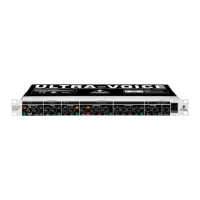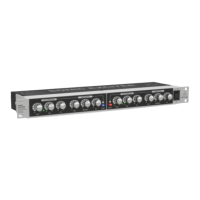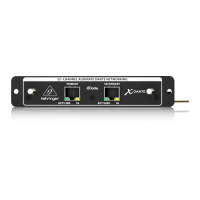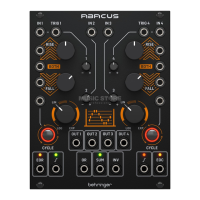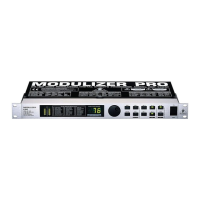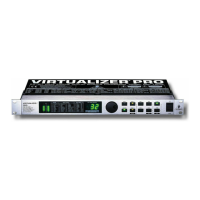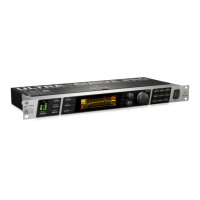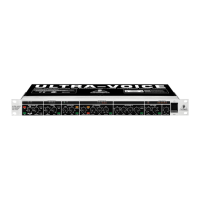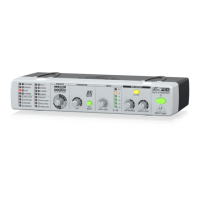Do you have a question about the Behringer ULTRAMIZER PRO DSP1400P and is the answer not in the manual?
Explains the digital design concept and features of the Ultramizer PRO.
Provides initial setup instructions, handling, and placement advice for the unit.
Details the front panel controls and their functions.
Explains how to use the Ultramizer function to increase loudness and density.
Describes how to set the maximum output level limiter for preventing clipping.
Details the Exciter function for adding transparency and depth to the audio signal.
Explains the Super Bass function for enhancing low frequencies and adding depth.
Describes the 3D Surround Processor for improving stereo width and spatial enhancement.
Explains the Denoiser function for removing unwanted noise from the audio signal.
Explains the crossover parameter for dividing the audio spectrum into bands.
Guides on how to select and recall user-defined presets.
Details the process of editing existing presets using the controls.
Explains how to save modified or new presets.
Covers how to configure and use MIDI settings for controlling the unit.
Provides guidance on setting optimal input and output levels for sound quality.
Discusses applications for the unit in studio recording and mastering scenarios.
Explains its use in analog recording to achieve optimal levels and prevent distortion.
Details its role in digital recording to avoid audible side effects and distortion.
Describes its application in mastering to increase volume without affecting dynamics.
Explains how the unit protects sound systems from distortion and damage.
Details system protection when using passive crossovers in loudspeakers.
Explains system protection when using active crossovers.
Discusses how to improve sound quality in PA systems with active crossovers.
Covers its use with multitrack machines to prevent distortion and minimize tape hiss.
Explains its application in broadcast for achieving maximum transmission volume.
Details its use in AM/TV broadcasting for limiting signal dynamics and optimizing power.
Explains its use with telephone lines and wireless systems to improve SNR and prevent overload.
Shows how to insert the unit into single channels, sub-groups, or main mix channels.
Describes how to integrate the unit into a MIDI setup for full control.
Explains how to archive presets using MIDI and external storage.
Explains the concept of audio dynamics and loudness perception.
Discusses inherent noise in electronic components and its impact on audio quality.
Explains the usable dynamic range of audio equipment and its limitations.
Details the function and operation of compressors and limiters in audio processing.
Explains the function of expanders and noise gates for reducing noise.
Describes the Denoiser function and its low-pass filter mechanism.
Discusses the history and function of the Exciter effect for enriching harmonics.
Explains the Super Bass processor for compensating low-frequency loss and adding presence.
Details the 3D Surround Processor's function in enhancing stereo width and spatial imaging.
Explains the process of converting analog audio signals to digital format (ADC/DAC).
Details the connectors and controls located on the rear panel of the unit.
Explains the procedure to reset the unit's settings to their original factory defaults.
Provides instructions for mounting the unit in a standard 19-inch rack.
Details how to connect the unit to the AC mains power supply safely.
Explains how to connect audio signals using balanced and unbalanced connections.
Describes how to establish MIDI connections for control and data transfer.
Explains how to set the operating level switch for different recording environments.
Provides a chart detailing MIDI functions and parameters.
Lists the technical specifications of the ULTRAMIZER PRO unit.
Explains the digital design concept and features of the Ultramizer PRO.
Provides initial setup instructions, handling, and placement advice for the unit.
Details the front panel controls and their functions.
Explains how to use the Ultramizer function to increase loudness and density.
Describes how to set the maximum output level limiter for preventing clipping.
Details the Exciter function for adding transparency and depth to the audio signal.
Explains the Super Bass function for enhancing low frequencies and adding depth.
Describes the 3D Surround Processor for improving stereo width and spatial enhancement.
Explains the Denoiser function for removing unwanted noise from the audio signal.
Explains the crossover parameter for dividing the audio spectrum into bands.
Guides on how to select and recall user-defined presets.
Details the process of editing existing presets using the controls.
Explains how to save modified or new presets.
Covers how to configure and use MIDI settings for controlling the unit.
Provides guidance on setting optimal input and output levels for sound quality.
Discusses applications for the unit in studio recording and mastering scenarios.
Explains its use in analog recording to achieve optimal levels and prevent distortion.
Details its role in digital recording to avoid audible side effects and distortion.
Describes its application in mastering to increase volume without affecting dynamics.
Explains how the unit protects sound systems from distortion and damage.
Details system protection when using passive crossovers in loudspeakers.
Explains system protection when using active crossovers.
Discusses how to improve sound quality in PA systems with active crossovers.
Covers its use with multitrack machines to prevent distortion and minimize tape hiss.
Explains its application in broadcast for achieving maximum transmission volume.
Details its use in AM/TV broadcasting for limiting signal dynamics and optimizing power.
Explains its use with telephone lines and wireless systems to improve SNR and prevent overload.
Shows how to insert the unit into single channels, sub-groups, or main mix channels.
Describes how to integrate the unit into a MIDI setup for full control.
Explains how to archive presets using MIDI and external storage.
Explains the concept of audio dynamics and loudness perception.
Discusses inherent noise in electronic components and its impact on audio quality.
Explains the usable dynamic range of audio equipment and its limitations.
Details the function and operation of compressors and limiters in audio processing.
Explains the function of expanders and noise gates for reducing noise.
Describes the Denoiser function and its low-pass filter mechanism.
Discusses the history and function of the Exciter effect for enriching harmonics.
Explains the Super Bass processor for compensating low-frequency loss and adding presence.
Details the 3D Surround Processor's function in enhancing stereo width and spatial imaging.
Explains the process of converting analog audio signals to digital format (ADC/DAC).
Details the connectors and controls located on the rear panel of the unit.
Explains the procedure to reset the unit's settings to their original factory defaults.
Provides instructions for mounting the unit in a standard 19-inch rack.
Details how to connect the unit to the AC mains power supply safely.
Explains how to connect audio signals using balanced and unbalanced connections.
Describes how to establish MIDI connections for control and data transfer.
Explains how to set the operating level switch for different recording environments.
Provides a chart detailing MIDI functions and parameters.
Lists the technical specifications of the ULTRAMIZER PRO unit.
| Inputs | 2 |
|---|---|
| Outputs | 2 |
| Power Supply | 100-240 V AC, 50/60 Hz |
| THD | < 0.05% |
| Category | Audio Processor |
| Input Connectors | XLR, 1/4" TRS |
| Output Connectors | XLR, 1/4" TRS |

